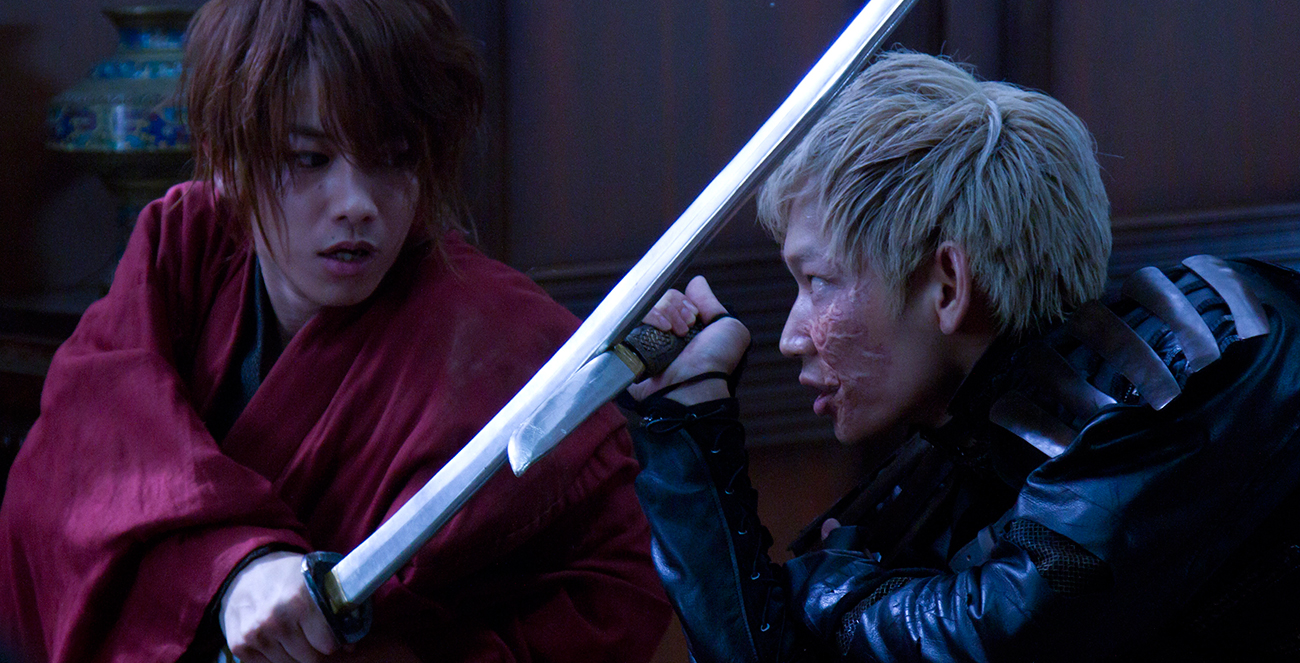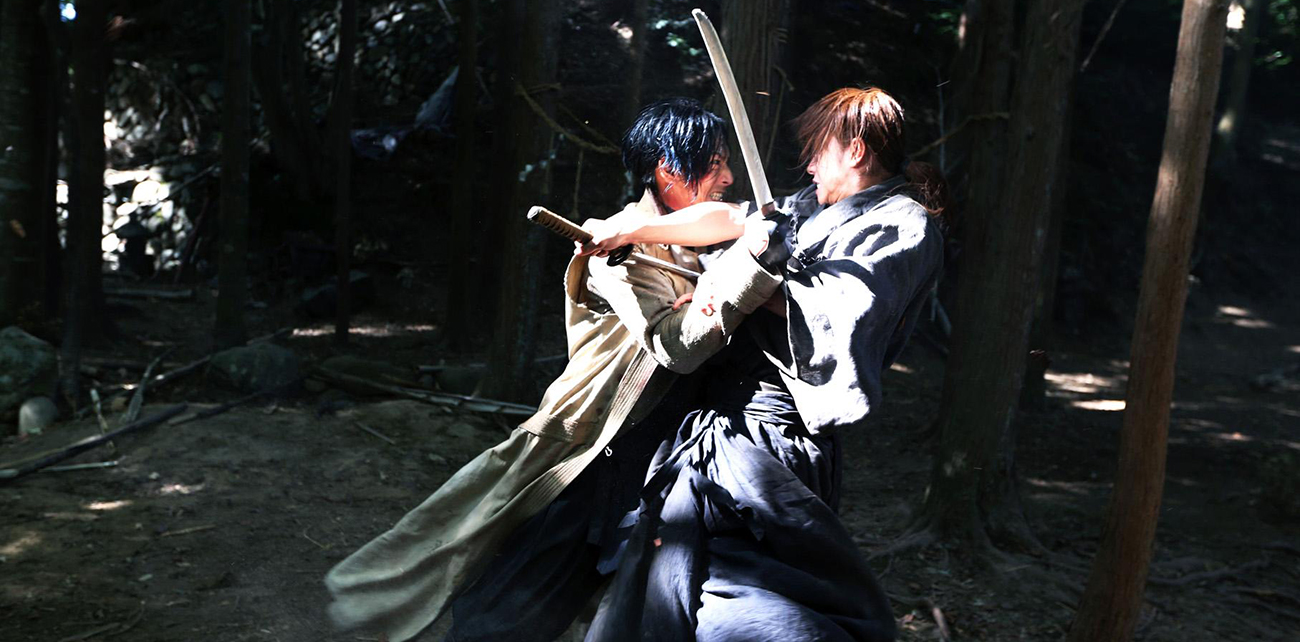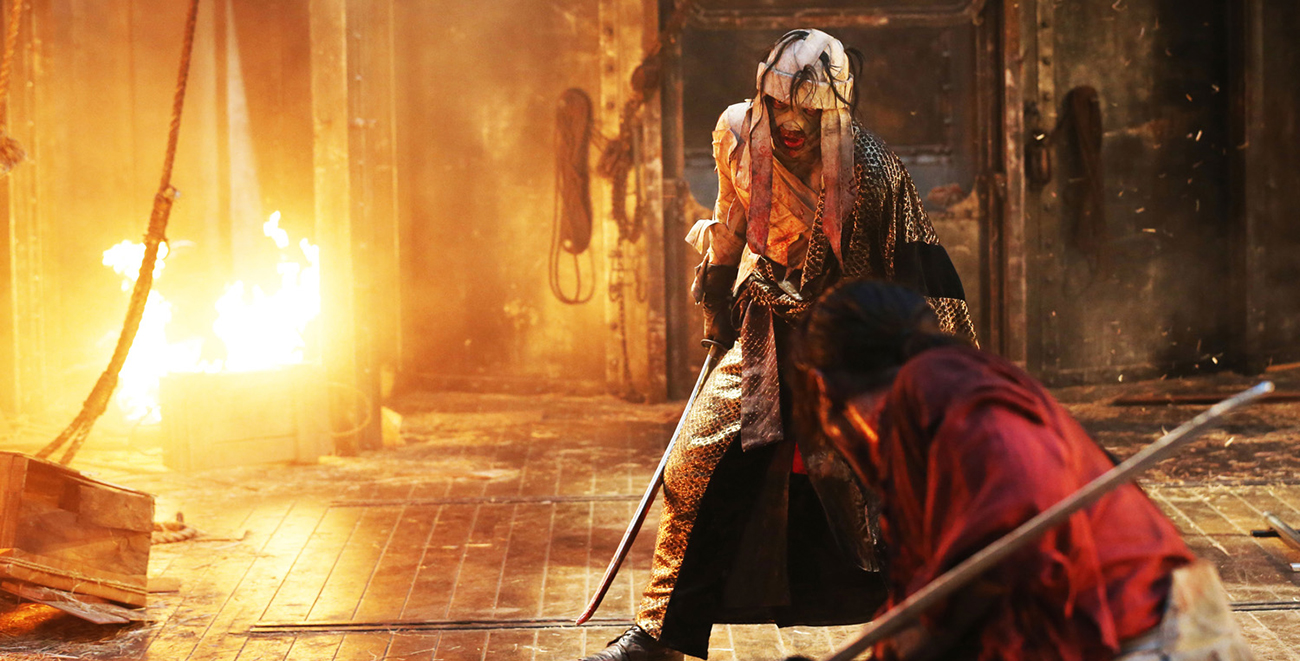Rurouni Kenshin
“My oath to never kill, is represented by my sakabato.” These are words spoken from the main character Himura Kenshin (Takeru Satoh) which sums up his character and his beliefs in this film.
Opening the film with a scene from the brutal Boshin war, we watch as the ending outcome of the war is welcomed by the beginning of the Meiji Era. The legendary and feared Hitokiri Battosai’s assistance in ending the war leads to the abandoning of his katana which is then picked up by one of the war’s survivors, Udo Jin-e (Koji Kikkawa).
Now, in 1878, ten years after the battle of Toba-Fushimi that took place in the Boshin War, the Meiji government rules the land and the infamous Hitokiri Battosai, now going by the name of Himura Kenshin, is back in Tokyo. While in the city, he befriends Kamiya Kaoru (Emi Takei), owner of her late father’s kendo school, after having saved her from the new Battosai, Udo Jin-e. Meanwhile, Takeda Kanryu (Teruyuki Kagawa) a wealthy and cruel businessman plans to control Japan by creating opium with the help of opium maker, Takani Megumi (Yu Aoi). When Kanyryu poisons the people of the town and Jin-e threatens the girl he cares for, Kenshin’s vows to never kill are put to the test.

Keishi Otomo, director and co-writer, along with Kiyomi Fuji, truly brings this ’90s manga to life with its fast paced fighting and sword-fight scenes – living up to how they were seen in the anime. It’s been a while since a samurai film has been as fast paced as Rurouni Kenshin, especially one that doesn’t rely on unnecessary slow motion to capture your attention throughout the movie. One memorable example from the film includes a fight in a kitchen where characters go all out and take a quick break during the fight to build to an even bigger finish. The film’s action is also impressive since there was limited use of CGI in the film, which is a great achievement in itself.
The casting for this film needs to be applauded too especially with the casting of Takeru Satoh as Himura Kenshin. The actors’ precise understanding of each character’s personality made the movie even more enjoyable, particularly as a fan of the anime. With the film’s blockbuster quality, it’s expected that these actors be able to bring a few laughs in between the serious moments of the film.
Whether or not you’re a fan of the anime or manga it’s based on, Rurouni Kenshin is still a great film. If you are a fan, just don’t expect this film to be exactly like the anime/manga because there are changes! With that said, fans of martial arts/samurai films will certainly get a kick of Rurouni Kenshin.
Rurouni Kenshin: Kyoto Inferno
“A man can never throw away his past.” Himura Kenshin (Takeru Satoh) tells this to Kamiya Kaoru (Emi Takei) as the legendary Hitokiri has once again been placed at a crossroad – should Kenshin leave his newly peaceful life to go back and help the government with their latest predicament?
Kicking off with a fierce opening scene, director Keishi Otomo returns for the second film in the Rurouni Kenshin trilogy. Otomo brings hell on Earth in the form of Kenshin’s new challenger, Shishio Makoto (Tatsuya Fujiwara), a former Hitokiri with his mind set on overthrowing the Meiji government so that he may take control of Japan.
The second arc of the Rurouni Kenshin trilogy is one hell of a step up in comparison to the first movie and will leaves you wanting more and in high anticipation of the trilogy’s finale. The fighting scenes and all the stunts in this film are of course at the top of their game, much like the first film. With more fights in the sequel this time around, there’s more than enough to keep your attention.

As previously established, the film does make some changes away from the source material, which this time includes the alteration of Shinomori Aoshi’s (Yusuke Iseya) origin. Though changes like these are to be expected, they fit well within the film and don’t distract. With that being said, it’s the little things that count – actors, including the new ones, are again rather precise with their characters, overshadowing any urge to nitpick away at everything.
In terms of newer characters like Seta Sojiro (Ryunosuke Kamiki), who smiles during his battles while skipping around and tapping his leg or Sawagejo Cho (Ryosuke Miura) with that big hair of his and his trademark squinting eye, it’s easy to appreciate the dedication made to put these characters in costume. The authenticity to match the stylized anime look of the world with its ‘real’ time period adds to the film’s success.
Rurouni Kenshin: Kyoto Inferno is a good sequel that sets itself up really nicely for the final conclusion of the Rurouni Kenshin trilogy.
Rurouni Kenshin: The Legend Ends
The trilogy comes to an end with appropriately titled, Rurouni Kenshin: The Legend Ends and it does not disappoint.
Following from the cliffhanger ending of Rurouni Kenshin: Kyoto Inferno, Himura Kenshin (Takeru Satoh) wakes up in to an unfamiliar environment which he soon discovers to be the house of his master. From there, the movie builds up with some expositional information concerning Kenshin’s master and about Kenshin’s past.
At times, it did feel unnecessary to have Kenshin’s time with his master go on for as long as it did, especially considering the ongoing story of villain Shishio (Tatsuya Fujiwara)’s ongoing takeover of Tokyo. Kenshin’s time with his master is necessary in the film however, as it is with his master that Kenshin learns an importance lesson and a special technique that would aid him in his battle against the film’s villains.

Like previous films, the action is just as good as what came before. This film particularly is outstanding in its action with one memorable sword-fighting scene starting from a beach to the deck of Shishio’s big black ship to inside the ship. The impeccable pacing of this scene as well as the swordplay on hand is enough to keep you on the edge of your seat.
And while director Otomo hasn’t relied too heavily on CGI in previous installments, the wonderful use of it here makes the film feel extra special. The effects used for Shishio’s fire-blasting sword (yes, you read right!) worked brilliantly and appeared rather realistic when it was unveiled (the fangirl inside me admittedly wept in happiness).
For the series to feature such a pacifist character as its protagonist, it’s quite amazing to see that the films have kept Kenshin’s oath through and through. Yet that doesn’t stop him and others around him from having some badass fight scenes! Rurouni Kenshin: The Legend Ends is a worthy conclusion to what has been a great series of Japanese blockbusters.
Catch the Rurouni Kenshin trilogy at the 2014 Japanese Film Festival.
